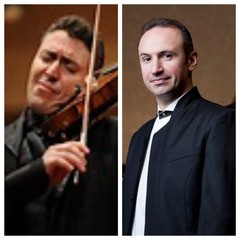|
Back
Fiddler’s Fireworks New York
Isaac Stern Auditorium, Carnegie Hall
01/20/2022 -
Wolfgang Amadeu Mozart: Violin Sonata in E Minor, K. 300c [304]
Sergei Prokofiev: Violin Sonata No. 1 in F Minor, Opus 80
César Franck: Violin Sonata in A Major
Maurice Ravel: Tzigane
Maxim Vengerov (Violin), Simon Trpceski (Piano)

M. Vengerov/S. Trpceski
“A table, a chair, a bowl of fruit and a violin; what else does a man need to be happy?”
Albert Einstein
The Carnegie Hall audience looking for a pleasant violin recital last night had to wait some 80 minutes for their wishes. The first half of the recital by Maxim Vengerov and Simon Trpceski was anything but pleasant, It was tragic and fierce, despondent at some point and with Tatar fury at another. And even the innocent movement of a Mozart minuet took on an rare tones.
No matter the content, we had two soloists at the top of their form. Mr. Vengerov has been called “the Pavarotti of the violin”, but this is misleading, since his Stradivarius violin has three times the range of the tenor, and infinitely more color.
Yes, Pavarotti had great control of his voice. But Mr. Vengerov’s timbre last night encompassed a whole cosmos of feeling, the most frightening low tone-colors (the opening of Prokofiev’s First Violin Sonata), and tricks in the Ravel Tzigane on the highest ranges.
His Macedonian-born partner Simon Trpceski (Mother Theresa’s Macedonia, not that of Alexander the Great), has inspired and curated musical ensembles there even as his international reputation has soared. Like Mr. Vengerov, he never feared extremes, and his percussive notes (actually percussion notes) in the Prokoviev, Mr. Trpceski almost made Carnegie Hall’s ceiling crack open.
That opening Mozart Sonata was the composer’s only minor-key piano sonata, but the composer skipped from mysterious to mirthful, as if challenging the artists. In that first movement, Mr. Vengerov led his partner, with a muscularity and sense of both joy and sadness. The minuet started quietly enough, but both artists ended with a grand climax.
The only phrase to describe the Prokofiev is more appropriate to Southeast Asia wilderness destruction: Slash and burn. Prokofiev put the violinist deep in the bowels of hell start off with, on the lowest registers. After this Mr. Vengerov slashed (physically, not the usual insouciance of fiddlers), setting loose his violin technical tricks.
Barely touching the strings at some points, letting the notes bounce away, growling at other points. The twists and turns of the second and fourth movements were shattering, sardonic.
Mr. Trpceski joined in the fury, stomping his notes at time, offering hazy, almost Impressionistic chords in the third movement.
This was such an extraordinary performance that I was tempted to leave in the intermission. But duty called, and that oft-played Franck Sonata started the second.
The audience had, yes, been stunned by the Prokofiev, but they obviously longed for something less...er...… Satanic.
The Franck so often comes near the cusp of the saccharine, and this is unfair. The composer’s emotional depth was deep and touching.
The team of Vengerov and Trpceski never allowed the Franck to sink into affected bathos. Vibrato was kept to a minimum, and the violinist–for the first time in the evening–let his soaring, operatic, powerful tones rise to their height.
Yes, the duo evidently loved playing with each other, and César Franck’s so difficult piano part (made for his extra-large hands?) was played beautifully. Yet this is still a violinist’s work, where Mr. Vengerov’s reputation was proved over and over again.
The last work was the ultimate showpiece for any fiddler, and the guaranteed audience-rising-to-their-feet piece for any recital. Is Maurice Ravel’s Tzigane any more than that?
Absolutely. Ravel gave more Gypsy feeling (without a single quote of Gypsy music) than Liszt. And it has structure, both for violin and piano.
Still, it is the violin who carries the first half. And I have never ever heard both the sheer technical magic of the instrumentalist–as well as the constant changes of tempos, of rubatos, of color which leaps from daring to glowing to resplendent.
The encores were like medicinal depressants to the Prokofiev and Ravel. Two Kreislers, one minor Fauré. But what could possibly follow the Tzigane? Personally I would have wished more exotic, more grotesque, more eccentric. A Bartók, a Stravinsky bagatelle... Still, one had such a bundle of other stupendous moments, one could forgive those extra little tunes. It was an amazing evening.
Harry Rolnick
|